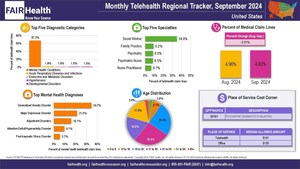FAIR Health Releases Interactive Tool Tracking Opioid Abuse and Dependence State by State
The Share of Patients Receiving Medical Services Who Had Opioid Abuse and Dependence Diagnoses Increased Seven Percent Nationally from 2020 to 2023
NEW YORK, Sept. 26, 2024 /PRNewswire/ -- Today FAIR Health released the Opioid Tracker, a free, interactive tool tracking opioid abuse and dependence state by state. A brief released simultaneously offers a user's guide to the Opioid Tracker.
Available on FAIR Health's website fairhealth.org, the Opioid Tracker includes a heat map representing the percentage of patients with opioid abuse and dependence diagnoses compared to all patients receiving medical services in 2023 for each state. Clicking on a state displays an infographic for that state. The infographic includes the top five procedure codes by utilization for opioid abuse and dependence, the top five procedure codes by aggregate allowed amounts for opioid abuse and dependence,[1] the change in the percentage of patients with opioid abuse and dependence diagnoses compared to all patients receiving medical services from 2020 to 2023, and the distribution of patients with opioid abuse and dependence diagnoses by age and gender. There is also a similar infographic for the nation as a whole. The source of the data is FAIR Health's repository of commercial healthcare claims, now at over 48 billion claim records, the largest such repository in the nation.
Among the key findings revealed by the Opioid Tracker:
- Nationally, the percentage of patients with opioid abuse and dependence diagnoses compared to all patients receiving medical services from 2020 to 2023 showed an overall increase. In 2020, patients with opioid abuse and dependence diagnoses accounted for 0.412 percent of all patients receiving medical services, while in 2023 they accounted for 0.442 percent, an increase of 7.3 percent.
- In 2023, procedure code H0020 (methadone administration and/or service) was the most commonly used code for opioid abuse and dependence, representing 20.6 percent of claim lines for all procedure codes for opioid abuse and dependence nationally.
- In terms of overall cost, H0018 (behavioral health short-term residential treatment program, no room and board, per diem) accounted for 11.9 percent of aggregate allowed amounts for opioid abuse and dependence in 2023, more than any other individual code.
- Nationally, 27.3 percent of opioid abuse and dependence diagnoses were attributable to patients in the 51 to 65 age group in 2023, more than any other age group.
- Males were 56.9 percent of patients with opioid abuse and dependence diagnoses in 2023, while females were 43.1 percent.
FAIR Health President Robin Gelburd stated: "The Opioid Tracker sheds light on multiple aspects of opioid abuse and dependence, including utilization, costs, age and gender. We hope that the Opioid Tracker will be useful to all healthcare stakeholders, such as policy makers, payors, providers, patients and researchers, as they continue to track and seek to better understand and address this public health issue."
For the Opioid Tracker, click here. For the user's guide to the Opioid Tracker, click here.
Follow us on X @FAIRHealth
About FAIR Health
FAIR Health is a national, independent nonprofit organization that qualifies as a public charity under section 501(c)(3) of the federal tax code. It is dedicated to bringing transparency to healthcare costs and health insurance information through data products, consumer resources and health systems research support. FAIR Health possesses the nation's largest collection of commercial healthcare claims data, which includes over 48 billion claim records and is growing at a rate of over 3 billion claim records a year. FAIR Health licenses its commercial data and data products—including benchmark modules, data visualizations, custom analytics and market indices—to commercial insurers and self-insurers, employers, providers, hospitals and healthcare systems, government agencies, researchers and others. Certified by the Centers for Medicare & Medicaid Services (CMS) as a national Qualified Entity, FAIR Health also receives data representing the experience of all individuals enrolled in traditional Medicare Parts A, B and D, which accounts for a separate collection of over 48 billion claim records; FAIR Health includes among the commercial claims data in its database, data on Medicare Advantage enrollees. FAIR Health can produce insightful analytic reports and data products based on combined Medicare and commercial claims data for government, providers, payors and other authorized users. FAIR Health's systems for processing and storing protected health information have earned HITRUST CSF certification and achieved AICPA SOC 2 Type 2 compliance by meeting the rigorous data security requirements of these standards. As a testament to the reliability and objectivity of FAIR Health data, the data have been incorporated in statutes and regulations around the country and designated as the official, neutral data source for a variety of state health programs, including workers' compensation and personal injury protection (PIP) programs. FAIR Health data serve as an official reference point in support of certain state balance billing laws that protect consumers against bills for surprise out-of-network and emergency services. FAIR Health also uses its database to power a free consumer website available in English and Spanish, which enables consumers to estimate and plan for their healthcare expenditures and offers a rich educational platform on health insurance. An English/Spanish mobile app offers the same educational platform in a concise format and links to the cost estimation tools. The website has been honored by the White House Summit on Smart Disclosure, the Agency for Healthcare Research and Quality (AHRQ), URAC, the eHealthcare Leadership Awards, appPicker, Employee Benefit News and Kiplinger's Personal Finance. For more information on FAIR Health, visit fairhealth.org.
Contact:
Rachel Kent
Executive Director of Communications and Marketing
FAIR Health
646-396-0795
[email protected]
[1] An allowed amount is the total negotiated, in-network fee paid to the provider under an insurance plan. It includes the amount that the health plan pays and the part the patient pays under the plan's in-network cost-sharing provisions (e.g., copay or coinsurance if the patient has met the deductible). The aggregate allowed amount for a given procedure is simply the sum of all the allowed amounts for that procedure in the applicable geographic area during the time frame.
SOURCE FAIR Health

WANT YOUR COMPANY'S NEWS FEATURED ON PRNEWSWIRE.COM?
Newsrooms &
Influencers
Digital Media
Outlets
Journalists
Opted In






Share this article